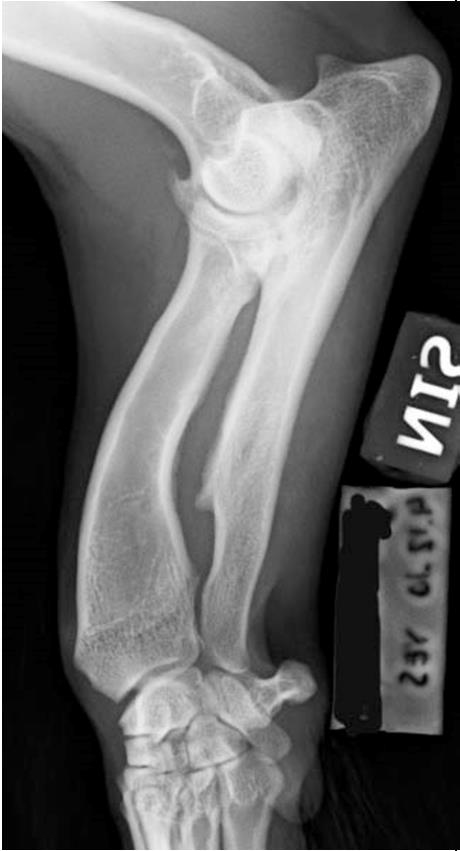Elbow joint incongruency
Developmental forelimb disorders in short-limbed breeds
A forearm of a dog consists of ulna and radius, which together with the humerus form the elbow joint. Radius and ulna articulate with carpal bones of the wrist.
Chondrodystrophic breeds have a hereditary developmental disorder of bones, which, starting already at the foetal stage, disrupts the growth of limb bones. Chondrodystrophic breeds typically have short limbs and a longish, low body. A typical example is the Dachshund and other breeds in this group include Pekingese, Basset Hound, Corgis, Swedish Vallhund, Skye Terrier, and Bichon Havanese. Quite different breeds, but all united by the same mutation causing short limbs.
Bones grow in length at the cartilaginous growth plates. The growing stops once the growth plates have ossified. All dogs of the chondrodystrophic breed group have shorter, thicker, and also more curved limb bones than dogs without the mutation . However, sometimes the growth line of the ulna closes prematurely and once the radius keeps on growing, the proportions of the bones become abnormal. This may lead to incongruity of the ulna, when a radius that is “too long” forms a step in the joint or the radius becomes excessively curvy. Sometimes, the radial head subluxates laterally. In some dogs, the disturbance appears as paws turning outwards and wrists turning inwards. The tendency for premature closure of growth plates in chondrodystrophic breeds is hereditary and therefore, it can be prevented by selective breeding.
A study on Skye Terriers (Lappalainen et al. 2016) showed that elbow joint incongruency is associated with so called puppy lameness, which is very common in the breed; about one third of all puppies are lame during the growth period and some of them even as adults. Dogs with moderate or severe incongruity of the elbow joint were the ones that presented with lameness in adolescence or adulthood. The study included 50 dogs, of which all dogs presenting with lameness in adulthood had also been lame in adolescence. One aim of the study was to develop a radiographic screening programme for short-limbed breeds. The imaging method and grading scheme for elbow dysplasia applied by the Finnish Kennel Club today are not suitable for short-limbed breeds as such since they do not take incongruity of the elbow joint into consideration.
Incongruity of the elbow joint is best seen on a radiograph where the joint is not flexed (opening angle 90 degrees or greater). In addition to the elbow joint, the forearm must be completely visible in the image. Incongruency is graded on a scale of INC0–INC3, where INC0 stands for congruent and INC3 for a severely incongruent joint.
In chondrodystrophic breeds, INC1 is still considered as “normal”, but elbow joints graded as INC2 and INC3 are clearly abnormal. When choosing dogs for breeding, dogs graded as INC0 and INC1 should be favoured. When using INC2 graded dogs for breeding, these should be mated with dogs graded as INC0 (or INC1, if enough dogs graded as INC0 do not exist in the breed).
INC3 grades dogs should not be used in breeding.
Source: - Developmental forelimb disorders in short-limbed breeds - INCOC



